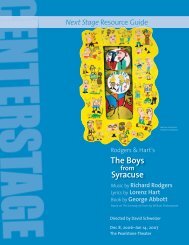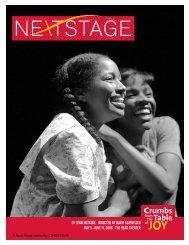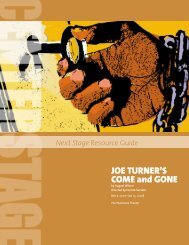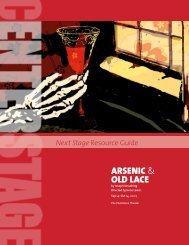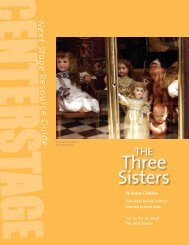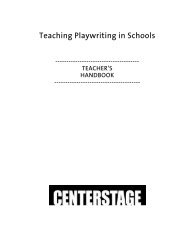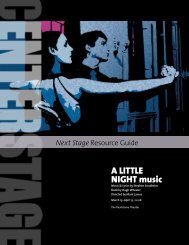The Matchmaker - Center Stage
The Matchmaker - Center Stage
The Matchmaker - Center Stage
You also want an ePaper? Increase the reach of your titles
YUMPU automatically turns print PDFs into web optimized ePapers that Google loves.
1863 New York<br />
is torn apart in<br />
July by the racially<br />
motivated Draft<br />
Riots. Untold<br />
numbers of African-<br />
Americans are<br />
murdered in the<br />
streets before<br />
the Union Army<br />
suppresses the<br />
agitators, many of<br />
whom are recent<br />
Irish immigrants<br />
enraged at being<br />
drafted into a war<br />
not of their making.<br />
1871 Cornelius<br />
“<strong>The</strong> Commodore”<br />
Vanderbilt designs<br />
and builds Grand<br />
Central Depot at<br />
42 nd Street and<br />
Park Avenue in<br />
order to compete<br />
with his archrival,<br />
the Pennsylvania<br />
Railroad. Vanderbilt<br />
would die in 1877,<br />
worth over 100<br />
million dollars—at<br />
the time, the richest<br />
man in American<br />
history.<br />
1871 Police open<br />
fire on an angry<br />
mob of Irish<br />
Catholics and<br />
Protestants in the<br />
city’s Orange riots,<br />
killing 51. Boss<br />
Tweed, ruler of<br />
the Tammany Hall<br />
political machine<br />
and Catholic<br />
sympathizer, is<br />
busted for graft by<br />
the New York Times<br />
as a direct result of<br />
the public outcry.<br />
1872 <strong>The</strong> New<br />
York Elevated<br />
Railway Company is<br />
formed, expanding<br />
from a stretch on<br />
Greenwich Street<br />
and Ninth Avenue<br />
up to 30 th Street.<br />
By 1876, elevated<br />
railways extend<br />
from the Battery to<br />
61 st Street. Horsedrawn<br />
carriages,<br />
as a result, are<br />
increasingly used by<br />
only the wealthy.<br />
1873 Central<br />
Park, designed<br />
by Frederick<br />
Law Olmsted,<br />
is completed<br />
in midtown<br />
Manhattan.<br />
Olmsted sought to<br />
emulate the idyllic<br />
landscapes and civic<br />
parks he saw on a<br />
trip to Europe in<br />
1850. <strong>The</strong> park was<br />
conceived as a new,<br />
democratic kind<br />
of public space—a<br />
man-made nature<br />
where New<br />
Yorkers of every<br />
class could seek a<br />
respite from urban<br />
overcrowding.<br />
1882 Working with<br />
the Central Labor<br />
Union of New York,<br />
carpenter Peter<br />
J. McGuire and<br />
machinist Matthew<br />
Maguire organized<br />
the country’s first<br />
Labor Day parade—<br />
10,000 people<br />
take to the streets<br />
on September 5 th .<br />
By 1887, President<br />
Cleveland officially<br />
supports the<br />
holiday, perhaps<br />
wishing to divert<br />
attention from<br />
Chicago’s bloody<br />
Haymarket Riot of<br />
the year before.<br />
1883 Alva and<br />
William Vanderbilt<br />
celebrate their new<br />
mansion on Fifth<br />
Avenue by spending<br />
a quarter of a<br />
million dollars on<br />
the most elaborate<br />
costume ball the<br />
city has yet seen.<br />
Sister-in-law Alice<br />
Vanderbilt comes<br />
dressed as “Electric<br />
Light” in a blinding<br />
white stain gown<br />
embroidered<br />
with diamonds,<br />
while her hostess<br />
Alva dresses as a<br />
Venetian princess,<br />
surrounded by a<br />
fluttering flock<br />
of real doves;<br />
Mrs. Caroline<br />
Schermerhorn<br />
Astor’s eventual<br />
appearance signifies<br />
that the upstart<br />
Vanderbilt clan<br />
has finally crashed<br />
the most tightly<br />
guarded social circle<br />
in the city.<br />
1883 After 13 years<br />
of construction, the<br />
Brooklyn Bridge<br />
opens on May 24 th ,<br />
to reported traffic of<br />
1,800 vehicles and<br />
150,300 people. <strong>The</strong><br />
largest suspension<br />
bridge in the world<br />
at the time, it also<br />
establishes an<br />
unprecedented<br />
means of<br />
pedestrian<br />
travel between<br />
Manhattan and<br />
Brooklyn.<br />
1886 To mark<br />
the American<br />
Centennial of 1876,<br />
France presents the<br />
United States with<br />
a gift: the Statue<br />
of Liberty.<br />
1889 Jacob<br />
Riis, New York’s<br />
preeminent<br />
muckraking<br />
journalist, begins<br />
publishing a<br />
photographic<br />
essay on life in the<br />
tenement slums in<br />
Scribner’s Magazine.<br />
Published as a book<br />
the following year,<br />
How the Other<br />
Half Lives inspires<br />
a young Police<br />
Commissioner<br />
named <strong>The</strong>odore<br />
Roosevelt to<br />
adopt reforms in<br />
the corrupt city<br />
government.<br />
1890 New York<br />
garment workers<br />
win the right to<br />
unionize July 25 th<br />
after a seven-month<br />
strike, securing<br />
agreements for a<br />
closed shop and the<br />
firing of all scabs.<br />
1892 <strong>The</strong> Ellis<br />
Island federal<br />
immigration station<br />
opens on New Year’s<br />
Day. Today, over 40<br />
percent of America’s<br />
population can<br />
trace their ancestry<br />
through the small<br />
island.<br />
1896 Captain<br />
Paul Boynton’s Sea<br />
Lion Park, the first<br />
amusement park<br />
at Coney Island,<br />
opens its doors,<br />
sparking a chain<br />
reaction of similar<br />
entertainments. A<br />
round-trip trolley<br />
ticket over the<br />
Brooklyn Bridge<br />
costs only 10 to 15<br />
cents, making outerborough<br />
travel<br />
possible for the<br />
masses.<br />
1898 <strong>The</strong> modern<br />
city of New York<br />
is formed, with<br />
Manhattan,<br />
Brooklyn, Staten<br />
Island, the Bronx,<br />
and Queens<br />
uniting as the Five<br />
Boroughs.<br />
1902 Quaker<br />
businessman R.H.<br />
Macy sells his New<br />
York department<br />
store to Isidor and<br />
Nathan Strauss,<br />
who move Macy’s<br />
from “the Ladies<br />
Mile” on 14 th Street<br />
to its present-day<br />
home at Herald<br />
Square, on the<br />
corner of 34 th Street<br />
and Broadway.<br />
1904 <strong>The</strong><br />
New York City<br />
underground<br />
subway system<br />
opens, the second<br />
in the country after<br />
Boston’s.<br />
Next <strong>Stage</strong>: <strong>The</strong> <strong>Matchmaker</strong> | 11



